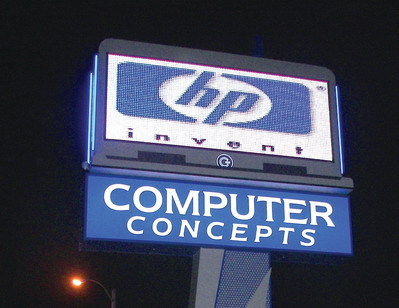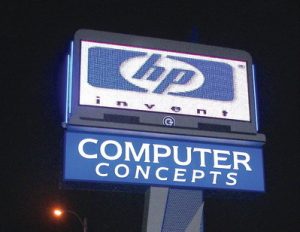Electric Signs
Selling Electronic Digital Signs in a Recession
Now’s the time to focus on the power of advertising.
Published
15 years agoon

For a creative salesperson, this is the time to be selling electronic-display advertising. People are afraid; business is down; advertising budgets are being slashed, and financing is tough. People aren’t buying signs, unless they must.
Perfect.
This is the time to focus on the reasons people use digital signs: The power of advertising’s impact, something no business can forego.
When times are tough, smart business people look for ways to trim budgets. Frequently, those who advertise most spend many worried hours staring at the ad budget to find items to cut. There’s no better opportunity than now to catch a business owner, in the throes of such an evaluation, with a new, low-cost, clearly focused advertising medium.
As a 30-year industry veteran, I’ve weathered several recessionary periods. My experience tells me it’s time to step back and evaluate where and how to prospect for new business.
AdvertisementThis may be a very new scenario for many of you. Because the digital-display industry has been on an extended roll, many salespeople don’t spend much time prospecting but, instead, respond to a steady stream of leads. If you fall into this category, pay particularly close attention.
If you learn to prospect for new, electronic-sign business, and focus on the power of advertising, you’ll find a new confidence that will serve you well in any economic condition.
Where to focus?
First, pinpoint the types of businesses that greatly benefit from vehicular visibility. “Place-based” businesses, or retail establishments that are positioned at a given location for a business advantage (usually traffic accessibility) are a goldmine. Cross-reference these with visible advertising expenditures in another medium.
Try starting with advertisements and work back to the business. The poor, beleaguered newspaper is the perfect target. The effectiveness of newspaper advertising, which is expensive, has decreased because of circulation declines.
As I quickly scan today’s paper, I see ads for three jewelry stores, a surgery clinic, a supermarket, a large credit union, a lighting center, a window-replacement company, a bar/restaurant, a real-estate company and a funeral home. These ads feature single-location businesses. Chain stores and products that can be bought in multiple locations (such as soft drinks) aren’t good prospects for this type of evaluation.
AdvertisementNext, evaluate each business location and measure it against traffic counts and local zoning. Unfortunately, two jewelry stores are in a mall. The window-replacement company isn’t on a main thoroughfare, and the surgery center is in an area with impossible zoning. These aren’t good options for electronic-digital signs.
But, one jewelry store and the supermarket are at stop lights on streets with monster traffic. The real-estate company and the funeral home are on a heavily traveled suburban road. On the edge of town, the lighting center is set back from a busy highway. The credit union and restaurant are on busy city streets with slower-moving traffic. These companies are prospects.
Study the paper every day. The Sunday newspaper features even more display ads, many of them for auto dealerships. Most likely, you’ll find advertisers who buy repeat ads throughout the week and larger ads on the weekend.
Other great prospects can be found on radio and television. Turn off XM, and store away the CDs. Listen to standard radio to note advertisers who still utilize this dying medium. Pay attention, especially, to the ads for single-location businesses.
Likewise, disconnect your TIVO and endure the TV commercials. Many local businesses, with one or two locations, still focus their advertising on broadcast media.
Just from these three media, you can gather viable candidates for digital-display advertising. From the competing media’s ad rates, you can extrapolate a base range. Many media companies’ websites provide advertising rate cards and coverage areas. More on this later.
AdvertisementYour digital-display knowledge
Electronic digital displays are versatile – they can be changed as often as needed and display an endless stream of advertising content. The content can be day-parted to reach specific audiences with timely ads.
They also display advertising to a mobile audience – specifically, the most likely customers – in front of the business that’s being advertised.
When I was a salesperson in Indianapolis, I carried a city map, which I mounted on a cardboard sheet. On it, I drew overlapping circles that represented the reach of the local radio stations and the local newspaper. I placed a dot on the map where the business was located and wrote the traffic count next to it. On the bottom of the map, I listed the newspapers’ circu¬lations and the stations’ reaches.
I would show the customer the map and point out his/her location. Then, I would point to a remote area of the city and ask, “What is the likelihood of someone over here responding to your ad in the newspaper or on the radio?”
The map made a dramatic impact, especially on car dealers. The answer was obvious. Would a Toyota prospect drive past a dealership nearby or go across town to look at the same cars? Why would a hungry guy drive across town for a steak special? Why would someone buy furniture across town if an adequate solution was nearby?
I would then compare the cost of a single, weekly newspaper display ad to the monthly lease cost of an ad that would run on a new digital display. I would compare the reach, talk about the primary market value and the value of the focused advertising.
Call for an appointment
I find cold-call appointments very effective. I use a very familiar tone when I ask for the business owner by name. Once through, I don’t identify myself as a sign salesperson. I ask if I could schedule a few minutes to discuss a more effective, and less expensive, new advertising medium than what the company currently uses. It’s amazing how many people will grant the meeting on that basis alone.
To prepare for the appointment, make a map. The Internet provides free maps and tools to create exactly the desired impression. Use the map to dramatically show your solution to the problem. Note your potential customer’s location, then the coverage of the local TV, radio and newspaper. Mention the growing number of available media sources, and explain how so many options dilute their advertising’s effectiveness. Then, ask this: Is advertising to large areas, or to a targeted audience, more effective?
Don’t presume to know his ad budget, but, instead, compare the cost of the advertising medium he uses without noting his particular expenditure.
Show the customer photos of digital-billboard advertising, and explain it’s the fastest-growing market segment of the advertising industry. Follow this with photos of on-premise digital signs that display creative ads. Point out that these businesses can enjoy the same creative benefits with the digital outdoor medium, but with total and exclusive control.
Discuss the display’s monthly lease cost, and compare it to the cost of another media. Mention that simply reducing the size or frequency of the other media would create the cash flow to incorporate the new medium.
Obviously, many variations on this theme exist. You need to find what’s most effective for your particular presentation style. But, regardless of your style, start the habit of prospecting for new business, and use the digital display as an alternative advertising option.
When the phones stop ringing, and business is dropping, it’s hard to interest customers in buying a new sign. But, people are always interested in new advertising schemes, particularly if it saves them money while increasing their effectiveness.
Cold-calling can be nerve-wracking, but it’s invigorating once you get started. You’ll be learning as you prospect, even when you hear “no.” You’ll improve your presentation, strengthen your tools and create an endless string of new, positive impressions.
As an experienced salesperson, I can tell you there’s no greater feeling than winning a sale that came from your own mind. Bringing a new idea to a prospect, converting that prospect to your way of thinking, and then closing the sale will bring you an extra, personal reward, as it does for me.
Read more about digital-display advertising at signweb.com. You can learn more about advertising effectiveness by visiting digitalooh.org. This site, and about digital outdoor advertising, contains concepts and tools equally valuable for the on-premise display salesperson.
Good selling.

SPONSORED VIDEO
Introducing the Sign Industry Podcast
The Sign Industry Podcast is a platform for every sign person out there — from the old-timers who bent neon and hand-lettered boats to those venturing into new technologies — we want to get their stories out for everyone to hear. Come join us and listen to stories, learn tricks or techniques, and get insights of what’s to come. We are the world’s second oldest profession. The folks who started the world’s oldest profession needed a sign.
You may like

Cincinnati Food Truck and Family of 12

Adams Outdoor Advertising Appoints CEO

Morgan Wallen Bar Sign Denied by Nashville Council
Subscribe

Bulletins
Get the most important news and business ideas from Signs of the Times magazine's news bulletin.
Most Popular
-

 News2 weeks ago
News2 weeks agoWoman Found Living Inside Supermarket Sign
-

 Real Deal2 weeks ago
Real Deal2 weeks agoA Family Sign Company Foists Their Youngest Upon the Business
-

 Photo Gallery1 week ago
Photo Gallery1 week ago17 Sneak Peeks at the American Sign Museum Main Street Expansion
-

 Ask Signs of the Times5 days ago
Ask Signs of the Times5 days agoWhen Should a Sign Company Move, Expand or Stay the Same?
-

 Editor's Note2 weeks ago
Editor's Note2 weeks agoThe Joy of Working
-

 Buzz Session6 days ago
Buzz Session6 days agoSign Companies on Subcontracting: Why or Why Not
-

 Benchmarks6 days ago
Benchmarks6 days ago5 Signs That Embody Care and Gratitude
-

 Tip Sheet1 week ago
Tip Sheet1 week agoReward Installers for Leads and Organization — Two of May’s Sign Tips













